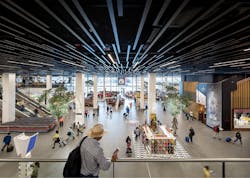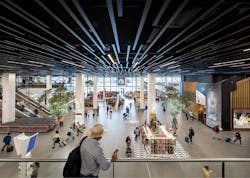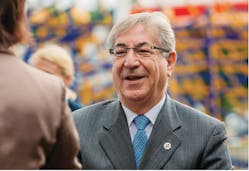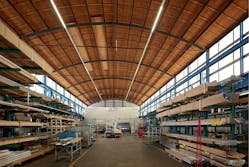If vendors retain luminaire ownership, they will have the incentive to look after longevity. Modular, replaceable components will also help. But will the industry move fast enough for EU regulations? MARK HALPER reports.
When Amsterdam’s Schiphol Airport chose to install new lighting from Philips without buying the luminaires three years ago (http://bit.ly/2Hoi84j), it was on the vanguard not only of the lighting-as-a-service (LaaS) business model but also of something for our resource-challenged times: the circular economy (Fig. 1).
FIG 1. Lighting-as-a-service contracts, such as Philips’ LaaS installation at Schiphol Airport’s Terminal 2, could play a big role in helping the circular economy take off in the lighting industry. Photo credit: Philips Lighting.
In case you haven’t heard, the circular economy endeavors to minimize waste across all industries by assuring the reuse of goods and their materials once an item’s usefulness has expired at a particular location. Circular principles minimize waste, but they also turn it into value. They contrast with the linear economy, where raw materials and products end up in the waste heap.
“Circular” is a concept intended to protect Earth and the environment while also in principle ensuring sustained economic vitality (http://bit.ly/2qBYGaJ). In lighting, vendors say they are all for it. The many circular possibilities include extending the life of luminaires by shifting to modular designs that allow easy replacement of parts and components such as LED light sources and modules; using more recycled materials in products; recovering metal or plastic housing for reuse; and so on.
But this all costs money, so the question is, what is the incentive for vendors? Green altruism will only go so far, which is probably to say not far at all. Then there’s regulation. In Europe, the European Union is drafting a Circular Economy Package that would impose many different legal requirements for a variety of circular practices by 2020, a timeframe that is easily a year or two before many people think lighting companies will be ready (Fig. 2).
So while the industry lobbies against a 2020 regulatory start, it is searching for the ultimate motivator to help embrace circular practices full-on. And that, of course, has everything to do with benefiting financially. If lighting firms cannot profit from circular practices, they will have much less motivation to abide by them. That all seems obvious enough, but in case not, the clue is in the name: It’s the circular economy, and an economy, by definition, is meant to make productive use of materials, resources, goods, and services.
As Philips Lighting’s head of sustainable innovation Anton Brummelhuis noted, “It is an economic system, which is important, because at the end of the day, businesses and people have to make money with it.” That’s not to say he is ignoring its goals. Brummelhuis is as staunch a believer in the circular economy as anyone, lauding its virtues. “It maximizes the reusability of products,” he noted. “Instead of heading to a landfill, we have to make sure that products and raw materials come back to the economy. And we to do this by maintaining the value. We have to minimize the destruction of value.”
But after more than a century of lighting’s linear economy, the switch to circular won’t be easy. “There is no one quick fix,” he said. “You need a systematic change. It’s a transformation. We expect this to take many years, maybe more than ten years.”
Value across the chain
Indeed, there is no single quick fix. But there are a couple of fundamental changes that could help usher in the new geometry. Perhaps top among them is the attempt by lighting vendors to move to an LaaS business model — such as the one in place at Schiphol’s Terminal 2 — in which vendors retain ownership of lights and luminaires while charging monthly fees for providing contracted illumination levels, maintenance, and upkeep including recycling and other end-of-life procedures (Fig. 3).
FIG 2. The European Commission’s Commissioner of Environment, Maritime Affairs and Fisheries Karmenu Vella is one of several EC chiefs pushing for measures that would have the lighting industry widely deploying modular luminaires by September 2020, a date that the industry says is too soon. Photo credit: Flickr/Wikimedia Commons.
From a customer perspective, LaaS is best known for helping end users avoid upfront capital costs. But it seems a perfect match for circular principles. Not only do LaaS deals typically reduce energy consumption and electricity bills — very much a part of the circular ethos in its own right — but the vendor is motivated to make longer-lasting and easier-to-reuse products, by virtue of retaining ownership. Once vendors continue to own lights after installation at an end-user site, they will have incentive to look after their longevity.
Circular thinking was one of the reasons that Schiphol articulated for deciding on its five-year LaaS contract, which, among other things, specifically allows Schiphol to return lights to Philips for reuse or recycling.
“Our choice for the new lighting in Lounge 2 shows that we take our responsibility in the use of raw materials resources and commit to our sustainability policy,” said André van den Berg, executive vice president and chief commercial officer for Schiphol Group, which has about two years to go on the contract and an option to extend for another five years. “This lighting offers maximum sustainability at all times and continuously secures the specified performance level.”
At least two other Philips LaaS contracts signed over the last 2–3 years also stipulate that Philips handle luminaire reuse. The High Tech Campus research park in Eindhoven, which is lighting its parking lot on a service basis, described the LaaS arrangement as a way of “future proofing” its lighting system. And Bruynzeel, a Dutch maker of shelving, cabinets, and other storage products, lauded the LaaS lighting at its Panningen, Holland facility for the “guaranteed reuse of the maximum number of lighting components,” which in turn would give Bruynzeel the ability to maximize recycling in line with its circular economy business agenda (Fig. 4).
While the three users mark early examples of deploying circular concepts in the form of a service contract, it’s not yet clear whether the contracts are profitable. In these early days, they will provide clues as to what works, and what doesn’t.
“The lighting industry sees the circular economy, circular thinking, as an opportunity,” said Ourania Georgoutsakou, secretary general of Brussels-based lighting industry trade group LightingEurope. “With opportunities come challenges. So the biggest thing we will all need to do is get our head around what does the circular economy mean in terms of product design, in terms of value change, in terms of business models, in terms of markets and customer expectations. I look at the circular economy as something that will change this industry and how we do business. That’s a transition process that everybody will have to come to grips with. It has different implications for different products and different companies.”
In short, she emphasized that the circular economy “will change the business models in the industry.”
To what? “That’s exactly the question,” Georgoutsakou replied.
Enter modularity
Service models should indeed play a big role, but there’s more to it than that. To help figure out the shift, at the time of this writing LightingEurope was about to commission a two-year study on the prospects of the service approach and other business model changes to help move toward a circular economy. The two-year study will look first at business and market opportunities, and in its latter stage will examine implication for materials, products, and components.
The report is expected to help put flesh on the bones of the circular economy skeleton that runs throughout the 10-year strategic roadmap that LightingEurope first issued two years ago, with circular gradually playing a more prominent role through the map’s final year in 2025.
It won’t be LightingEurope’s first publication on “circular.” Last October, it issued a white paper outlining four key circular components — extending product lifetime, refurbishing, harvesting parts from disused products, and recycling (http://bit.ly/2qBiRpb).
One commercial aspect expected to play a big role is “modularity” — designing luminaires with replaceable parts including LED modules as well as casings, power supplies, cabling, control gear, and other components (http://bit.ly/2HrVkAJ). It is a key element in potentially extending product lifetimes. Modularity marks a major departure from what the industry calls “sealed for life,” which defines many luminaires today that, like Apple iPhones with non-replaceable batteries, become altogether useless to the end user.
“If an LED luminaire breaks down and you have to chuck the whole thing out, that’s not very good for the environment,” observed Nigel Harvey, CEO of Recolight, a non-profit Croydon, England-based company that oversees lamp and luminaire recycling in the UK (http://bit.ly/2HrVLuY). “By making products more modular, you reduce the waste. At the end of a contract, it’s possible that the producer gets back 1000 or 2000 luminaires. And the producer is the company best placed to check them, upgrade them, refurbish them, add in new LED modules, and make them subsequently available for further use. It’s creating an extra revenue stream for the producer when those come back end of life.”
It’s a sentiment widely shared across the industry. “There’s far too much of a throwaway economy these days,” said Peter Hunt, chief operating officer of British trade group the Lighting Industry Association (LIA), which runs a lamps and luminaire recycling scheme called Lumicom. “It worries me to put so much product in landfill.”
One big challenge is to develop standards that would support easy replaceability across brands, ensuring that, say, an LED module from one vendor would snap into another vendor’s luminaire. But as is generally the case with any standards evolution, in today’s early stages of modularity, there is competition among potential competing standards. The Zhaga Consortium is one group that has been supporting interchangeable parts for several years, but it is not the only one (http://bit.ly/2qCrgbS).
“We see a variety out there on the market,” noted LightingEurope’s Georgoutsakou. “It exists to a certain degree for certain components and not for others, and to a certain degree for certain applications and not for others. You will need some kind of level of harmonization and standards. It will be a sign of maturity when we have more standardization.”
The LIA’s Hunt echoed that view. “It’s a bit like the VHS–Betamax story; it will all be played out in the marketplace,” he commented.
FIG 3. The LaaS agreement at Schiphol also specifies lighting levels. Photo credit: Philips Lighting.
While modularity already exists, it is not yet the common form. “The main portion of luminaires on the market today are not modular at all,” said Stéphane Himber, public affairs officer at Osram. The so-called “sealed for life luminaires” represent between 90% and 100% of all consumer LED luminaires, and they also have a high majority share in the professional market, Himber estimated. He noted that altering that mix to a higher modular ratio will require action across the value chain — not just from vendors like Osram but also from end users who themselves need to embrace circular principles and buy goods and services that recognize their value. Government-mandated “green public procurement” procedures, which are increasingly emerging, would also help.
“Today’s modularity can be seen as basic, as a beginning,” Himber said.
What about warranties and guarantees?
One legal roadblock is that guarantees and warranties do not permit cross-brand replacements on an Osram luminaire, a sticky wicket that describes the situation for many vendors. As Himber noted, in Osram’s case, “You can open the luminaire, you change the LED module and the light source, you can change the control gear, but you can only do that with Osram internal components.”
The emergence of a standard approach to modularity would help encourage vendors such as Osram to allow replacement parts from other vendors, he noted.
Such modularity policies would certainly help in today’s environment where users still tend to purchase lights rather than lighting services. But they would continue to be important in a service-driven business model. Modularity in general could help a vendor keep a customer up to date with the latest in light source technology, in which vendors strive for new and improved iterations every 9–18 months or so.
Not all products will suit modularity. For instance, retail shops, hotels, and restaurants that might redesign their premises every so many years could be inclined to simply abandon their existing luminaires for new ones with an entirely different look (even there, perhaps there is room for reusing the LED module).
Aside from modularity, it behooves lighting companies to investigate other ways to abide by circular principles, such as using more recycled materials in their products, whether metals or plastics.
Another issue looms: When LED lamps and luminaires have to hit the recycle heap, they are much more difficult to process than more conventional lighting products. Compared to fluorescent products, LEDs have more materials, and those materials, as well as overall shapes and sizes of components and end products, vary far more widely than in traditional wares.
Whereas more than 90% of fluorescent tube material is recovered today in the UK, “with LED lamps, you’d be lucky to get 50%,” Recolight’s Harvey said. “One of the benefits of LED technology is there’s been an explosion in the range of materials that are used, the designs that are used, the shapes, the sizes, everything. They allow for much more innovation in the way product is made. But that heterogeneity of product comes at a cost when it comes to recycling. You’ve got so many more materials in there. They are bonded together, often with glues and foams that make separation of them using mechanical processes very difficult. You’ve got all types of materials in there from plastics, glass, ceramics, aluminum, copper. You have PCBs [printed-circuit boards]. It’s a complete mixture. We have a problem that’s going to come back and bite us,” he noted.
LIA’s Hunt observed that the answer in part is to treat LED-based products as electrical equipment — regulated under Europe’s WEEE (Waste Electrical and Electronic Equipment) laws — rather than as conventional lighting products. On the positive side for LEDs, many of the luminaires that LIA collects are discarded conventional street lights housed in fiberglass, which Hunt noted is difficult to recycle and thus has low recycling value. The aluminum that tends to encase LED street lamps should have much higher value when the time comes to recycle those, he noted.
Industry versus the regulators
The transition to a circular economy will indeed be challenging for the industry. It’s hard to find outright opposition to it — that would be like campaigning against Mom and apple pie.
What is of concern, however, is the timeframe that the European Union wants to impose. LightingEurope’s Georgoutsakou noted that the Circular Economy Package that the European Commission is pushing could become law by September 2020 across all industries, requiring measures in lighting such as a shift by then to modular practices.
“We agree with the vision, we agree with the objectives, it’s on our strategic roadmap,” said Georgoutsakou. “But we don’t agree with the timeline.” She rattles off a list of reasons why it is too soon to impose modularity across the board on all lighting products. Among them is that sealed luminaires are often required for intellectual property reasons, or for safety. These concerns need consideration.
“We’re saying that kind of mandatory requirement [for easily replaceable parts by 2020] across the board, without looking at the application, the use scenario, the specific performance, and safety requirements of that application, is not a good idea. We are very happy to work with [the EU] on a detailed impact assessment so that when we review this legislation again in 2022, we can move forward with more requirements if they’re needed,” stated Georgoutsakou.
FIG 4. Bruynzeel lauded its LaaS agreement with Philips for “the guaranteed reuse of the maximum number of lighting components.” Photo credit: Philips Lighting.
The LIA’s Hunt agreed. “We don’t like the idea of too many mandatory requirements being forced on the industry too early,” he said. One possible consequence would be that requirements for modularity could chill innovation, such as the move toward making LED modules and components smaller.
“We’re constantly discovering new applications, miniaturization of light sources and luminaires,” Hunt said. “If we are forced into replaceability with standard products, that might restrict the designability of manufacturers. So I support the circular economy, as long as it doesn’t restrict what LEDs can do.”
While industry and government look like they are heading together in the same direction, they are not necessarily traveling together in a straight line. Round and round this could go.
MARK HALPER is a contributing editor for LEDs Magazine, and an energy, technology, and business journalist ([email protected]).









